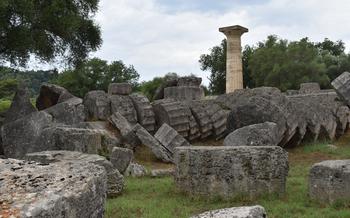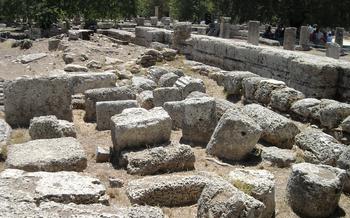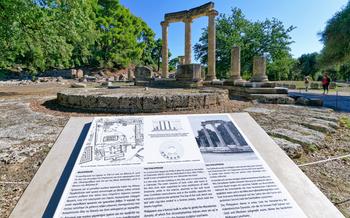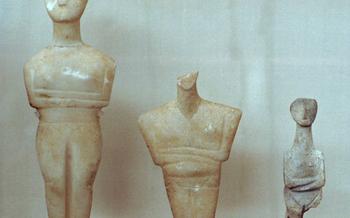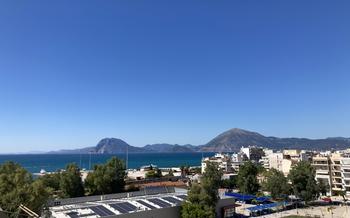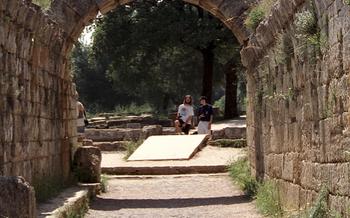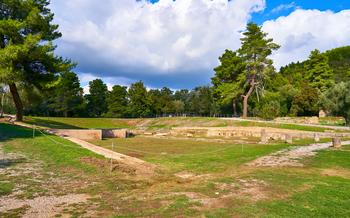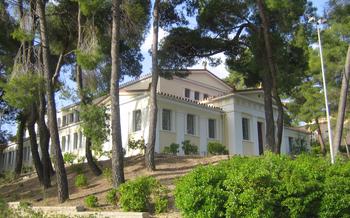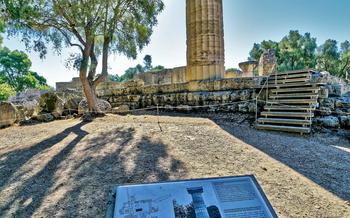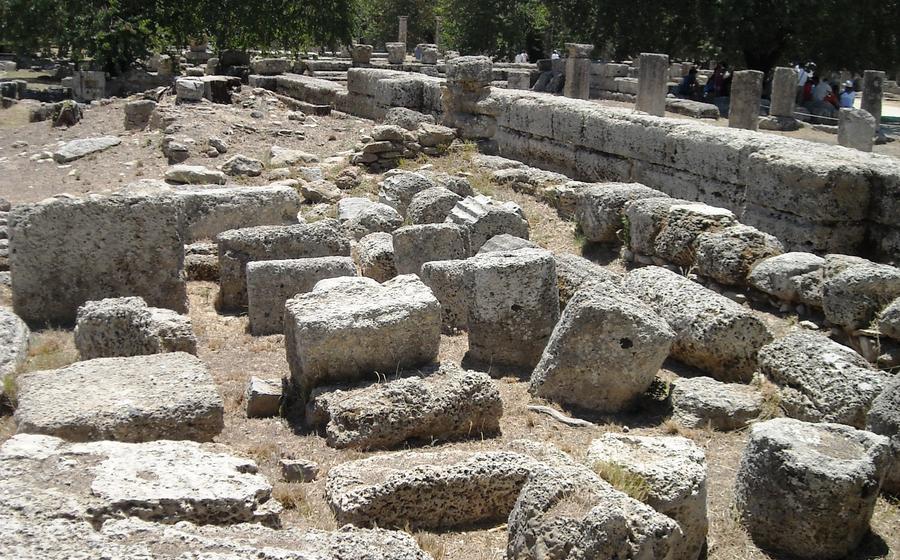
Bassae (Vasses)
- Olympia: A Realm of History and Mythology
- Explore the Archaeological Museum of Olympia
- Witness the Altar of Zeus: A Sacred Space
- Delve into the history of the Olympic Games
- Uncover the Treasuries: Ancient Offerings
- Marvel at the Nike of Paionios: A Masterpiece
- Explore the Leonidaion: A Place of Honor
- Immerse Yourself in the Peloponnese Region
- Practical Tips for Visiting Bassae (Vasses)
- Safety and Precautions
- Recommended Tours and Itineraries
- Local Customs and Etiquette
- Photography and Videography
- Insider Tip: Hidden Gem - Kladeos River and the Temple of Hera
Olympia: A Realm of History and Mythology
Olympia, a sacred site nestled in the western Peloponnese, holds a profound place in Greek history, mythology, and culture. Once a sanctuary dedicated to the almighty Zeus, Olympia served as the birthplace of the ancient Olympic Games, the most celebrated athletic and religious festival in the ancient world. The archaeological treasures unearthed at this site, including the majestic Temple of Zeus and the iconic statue of Nike, offer a glimpse into the grandeur and spiritual significance of this ancient sanctuary.
As you wander through the ruins of Olympia, you'll be transported back in time, surrounded by remnants of a civilization that revered athleticism, artistry, and the divine. Feel the energy of the ancient athletes as you stand on the starting line of the Olympic stadium, and imagine the roar of the crowd cheering on their heroes. Discover the myths and legends that permeate every corner of this sacred site, where gods and mortals intertwined in a world of wonder and awe.
Explore the Archaeological Museum of Olympia
The Archaeological Museum of Olympia is an astounding treasure trove, housing an extensive collection of artifacts unearthed from the ancient site. It stands as a testament to the artistic achievements and cultural heritage of ancient Greece. Within its walls, you'll embark on a journey through time, delving into the lives and beliefs of the people who once called Olympia home.
Marvel at the exquisite sculptures that grace the museum's galleries, each a testament to the skill and artistry of ancient Greek craftsmen. Witness the intricate details and lifelike expressions captured in marble and bronze. From majestic statues of gods and goddesses to delicate figurines depicting everyday life, these works of art offer a glimpse into the creative spirit of a bygone era.
In addition to sculptures, the museum showcases an array of pottery, bronzes, jewelry, and other artifacts. These objects provide valuable insights into the daily lives, religious practices, and economic activities of the ancient Greeks. Admire the intricate designs and motifs adorning pottery vessels, each telling a unique story. Handle bronze tools and weapons, feeling the weight of history in your hands.
Interactive exhibits and educational programs at the museum bring the ancient world to life. Learn about the history and significance of the Olympic Games, the role of religion in ancient Greek society, and the artistic techniques employed by Greek artisans. Engage in hands-on activities that allow you to experience the past in a tangible way.
A visit to the Archaeological Museum of Olympia is an essential complement to your exploration of the ancient site. It offers a deeper understanding of the rich history and culture of Olympia, providing a context for the ruins you'll encounter as you wander through the sacred grounds.
Witness the Altar of Zeus: A Sacred Space
At the heart of the Altis, the sacred precinct of Olympia, stands the Altar of Zeus, a monumental structure that served as a central focal point for religious ceremonies and rituals during ancient times. This colossal altar, constructed from massive blocks of limestone, was approximately 32 meters in length, 16 meters in width, and reached a height of over 2 meters.
The Altar of Zeus played a pivotal role in the ancient Olympic Games and religious festivals held in honor of Zeus, the king of the gods. It was here that animals were sacrificed as offerings to Zeus and other deities, and the smoke from the burning sacrifices rose towards the heavens, carrying with it prayers and supplications from the faithful.
The architectural design of the altar reflects the importance and grandeur of the rituals performed upon it. The altar's massive platform was surrounded by a stepped crepidoma, or base, and adorned with intricate moldings and decorative elements. The top of the altar featured a large central hearth, where the sacrificial fires were lit, surrounded by a series of channels and drains designed to collect the blood and ashes from the sacrifices.
The Altar of Zeus stands as a testament to the religious significance of Olympia in ancient Greece. It represents the deep connection between the Olympic Games and religious practices, and its enduring presence evokes a sense of awe and reverence for the sacred rituals that once took place here.
Delve into the history of the Olympic Games
Olympia was the birthplace of the ancient Olympic Games, one of the most significant and enduring events in human history. The Games originated as a religious festival honoring Zeus, the king of the gods, and featured a variety of athletic competitions, including running, wrestling, boxing, and chariot racing. The Games were held every four years, and athletes from all over Greece and beyond came to compete for glory and honor.
The ancient Olympic Games were not just about sports; they also had a profound cultural and social impact. They were a time for people from different city-states to come together and celebrate their shared Hellenic heritage. The Games also served as a platform for cultural exchange and the promotion of peace and understanding among the Greek city-states.
The legacy of the ancient Olympic Games is still felt today. The modern Olympic Games, which were revived in 1896, are directly inspired by their ancient predecessors. The Olympic spirit of competition, sportsmanship, and international unity continues to inspire athletes and fans around the world.
Uncover the Treasuries: Ancient Offerings
Scattered around the sanctuary of Olympia, the treasuries stand as testaments to the wealth and piety of ancient Greek city-states. These small, temple-like structures served as repositories for votive offerings, dedications, and other precious objects presented to the gods, particularly Zeus. Built in various architectural styles, each treasury showcased the distinctive artistic traditions of its respective city.
One of the most notable treasuries is the Treasury of Athens, constructed in the mid-5th century BC. Its Doric façade and intricate sculptures depict the legendary battle between the gods and the giants, symbolizing the triumph of order over chaos. Inside, visitors can admire a wealth of artifacts, including bronze statues, ceramic vessels, and gold ornaments.
Another remarkable treasury is the Treasury of Delphi, dating back to the 6th century BC. Built in the Ionic style, this treasury features a frieze adorned with scenes from the Trojan War. Among the offerings found within were gold and silver vessels, jewelry, and a bronze statue of Apollo, the patron god of Delphi.
These treasuries offer a glimpse into the religious practices and artistic achievements of ancient Greece. They also serve as reminders of the pan-Hellenic nature of the Olympic Games, which attracted athletes, pilgrims, and visitors from across the Greek world to honor Zeus and celebrate the Olympic ideals.
Marvel at the Nike of Paionios: A Masterpiece
Among the remarkable treasures of Olympia, the Nike of Paionios stands out as an exquisite masterpiece of ancient Greek art. Created by the renowned sculptor Paionios of Mende around the 5th century BC, this awe-inspiring statue embodies the essence of divine grace and athletic triumph.
The Nike of Paionios depicts the goddess Nike, the personification of victory, in a moment of triumphant celebration. With her wings outstretched and a gentle smile adorning her face, she stands poised on a triangular base, her weight gracefully shifted onto one leg. Her flowing drapery, intricately carved with delicate folds and intricate patterns, adds a sense of movement and fluidity to the sculpture.
This iconic statue holds immense historical significance as it was commissioned to commemorate the victory of the Messenians over the Spartans in the Battle of Sphacteria in 425 BC. Originally positioned atop a victory monument, the Nike of Paionios served as a symbol of triumph and a tribute to the prowess of the Messenian warriors.
In 1875, during the archaeological excavations at Olympia, the Nike of Paionios was discovered in remarkably well-preserved condition. This remarkable find has since become a centerpiece of the Archaeological Museum of Olympia, where visitors can marvel at its exquisite craftsmanship and timeless beauty.
The Nike of Paionios is not just a work of art; it is a testament to the enduring spirit of victory and the artistic brilliance of ancient Greece. Its graceful posture, intricate details, and historical significance make it an absolute must-see for anyone visiting Olympia.
Explore the Leonidaion: A Place of Honor
The Leonidaion, a prominent structure within the sacred precinct of Olympia, holds significant historical and architectural importance. Built in the 4th century BC, it served as a prestigious guesthouse for distinguished visitors and officials attending the Olympic Games.
The Leonidaion's grand design reflects its elevated status. Constructed from local limestone, the building features a Doric colonnade and a spacious interior divided into multiple chambers. Its well-preserved remains showcase the exceptional craftsmanship and architectural prowess of ancient Greek builders.
Beyond its practical function, the Leonidaion held symbolic significance. It represented Sparta's enduring influence and prestige within the Olympic Games. The city-state of Sparta, renowned for its military prowess and adherence to strict discipline, played a pivotal role in shaping the ethos and traditions of the ancient Games.
The Leonidaion serves as a testament to the interconnectedness of sports, politics, and cultural exchange in ancient Greece. It stands as a reminder of the Games' ability to bridge divides and foster unity among the diverse city-states of the Hellenic world.
Immerse Yourself in the Peloponnese Region
Olympia is situated in the heart of the Peloponnese, a region renowned for its natural beauty, rich history, and diverse cultural heritage. Beyond the ancient ruins, the Peloponnese offers a wealth of experiences for travelers seeking to delve deeper into Greek traditions and landscapes.
Explore the Diverse Landscapes:
The Peloponnese boasts a stunning variety of landscapes, from rugged mountains and lush valleys to pristine beaches and sparkling coastlines. Hike through the scenic Menalon Trail, marvel at the cascading waterfalls of Polilimnio, or soak up the sun on the golden sands of Voidokilia Beach.
Discover Historical and Cultural Treasures:
The Peloponnese is home to numerous historical sites and cultural landmarks. Visit the ancient city of Mycenae, with its impressive Lion Gate and Treasury of Atreus. Explore the medieval castles of Monemvasia and Methoni, which offer breathtaking views of the surrounding landscapes.
Experience Local Traditions and Festivals:
The Peloponnese is renowned for its vibrant local traditions and festivals. Immerse yourself in the lively Carnival celebrations in Patras, witness the traditional dances and music at the Kalamata International Dance Festival, or savor the delicious flavors of Peloponnesian cuisine at local festivals throughout the year.
Explore Traditional Villages and Monasteries:
The Peloponnese is dotted with charming traditional villages, each with its unique character and traditions. Wander through the cobbled streets of Dimitsana, admire the Byzantine architecture of Mystras, or visit the historic monasteries of Mount Taygetos, which offer panoramic views of the region.
By venturing beyond Olympia, travelers can immerse themselves in the rich tapestry of the Peloponnese, discovering its natural wonders, historical treasures, and vibrant local culture.
Practical Tips for Visiting Bassae (Vasses)
To make the most of your visit to Bassae (Vasses), consider the following practical tips:
-
Best Time to Visit: Spring (March-May) and autumn (September-November) offer pleasant weather for exploring the site. Summers can be hot and crowded, while winters are cold and may limit access to certain areas.
-
Transportation: Olympia is easily accessible by bus or train from Athens or Kalamata. Renting a car is also an option for those who prefer flexibility and want to explore the surrounding region.
-
Accommodation and Dining: There are limited accommodation options in Vasses itself, so it's best to book in advance or consider staying in nearby towns like Andritsaina or Karitaina. Dining options are also limited, so it's advisable to bring snacks or pack a lunch if planning to spend a full day exploring the site.
-
Guided Tours: Guided tours are available, providing valuable insights into the history and significance of the temple and the surrounding area. It's recommended to book a tour in advance, especially during peak season.
-
Self-Guided Exploration: For those who prefer to explore at their own pace, a self-guided visit is also possible. Information panels and brochures are available at the site to help visitors understand its history and significance.
Safety and Precautions
When traveling to Olympia, the safety of visitors is of utmost importance. Here are some general safety tips to keep in mind:
- Be aware of your surroundings and belongings. Keep an eye on your valuables, especially in crowded areas.
- Stay hydrated, especially during the summer months. The Greek sun can be intense, so drink plenty of water to avoid dehydration.
- Wear comfortable shoes. You'll be doing a lot of walking while exploring Olympia, so make sure your footwear is supportive and appropriate for the terrain.
- Respect the local culture and customs. Be mindful of your behavior and dress appropriately when visiting religious sites or interacting with locals.
In addition to these general tips, here are some specific safety considerations for visiting Olympia:
- Be careful when exploring the archaeological site. The ruins can be uneven and slippery, so watch your step and wear sturdy shoes.
- Stay on marked trails. There are designated paths for visitors to follow, so stay on these trails to avoid damaging the site or getting lost.
- Be aware of the weather conditions. The weather in Greece can be unpredictable, so check the forecast before you visit and be prepared for rain or strong winds.
In case of an emergency, contact the local authorities by dialing 1You can also seek assistance from your hotel or tour guide.
Recommended Tours and Itineraries
To make the most of your visit to Olympia, consider joining a guided tour or organized excursion. These tours offer insights and historical context from knowledgeable guides, allowing you to delve deeper into the significance of the site. Various tour options are available, ranging from half-day trips to multi-day itineraries that explore the broader Peloponnese region.
If you prefer a more independent experience, plan your itinerary carefully to maximize your time at Olympia. Allocate at least half a day to explore the archaeological site, including the Temple of Zeus, the Archaeological Museum, and other key attractions. Consider dedicating a full day to immerse yourself in the history and culture of the region, including a visit to the nearby town of Ancient Elis.
When planning your itinerary, take into account the time of year and weather conditions. The summer months can be hot and crowded, so consider visiting during the shoulder seasons (spring or autumn) for a more comfortable experience. Be sure to wear comfortable shoes as the site involves a fair amount of walking on uneven terrain.
For a truly unique experience, consider combining your visit to Olympia with a broader exploration of the Peloponnese region. This diverse region boasts stunning natural landscapes, ancient ruins, traditional villages, and vibrant local culture. Allow several days to explore highlights such as the medieval town of Monemvasia, the scenic Mani Peninsula, and the historic city of Nafplio.
Local Customs and Etiquette
When visiting Olympia, it is important to be mindful of local customs and etiquette. Greece is a country with a rich cultural heritage, and its people are proud of their traditions. Here are some tips to help you navigate social interactions respectfully:
-
Greetings: A handshake is the customary greeting, accompanied by a warm smile and eye contact. When meeting someone for the first time, it is polite to say "Kalimera" (good morning) or "Kalispera" (good evening).
-
Personal Space: Greeks tend to stand closer to each other when conversing than in some other cultures. Be prepared for a more intimate personal space and avoid backing away.
-
Body Language: Animated gestures and facial expressions are common in Greek communication. Don't be surprised if someone uses their hands or eyebrows to emphasize a point.
-
Respect for Elders: Older individuals are highly respected in Greek society. Show deference to elders by addressing them with the formal "Kyrios" (Mr.) or "Kyria" (Mrs.).
-
Tipping: Tipping is customary in restaurants, cafes, and bars. A 10-15% tip is considered appropriate.
-
Religious Etiquette: Greece is a predominantly Orthodox Christian country. Be respectful of religious customs and dress modestly when visiting churches or monasteries.
-
Photography: It is generally acceptable to take photos in public places, but be mindful of people's privacy and ask permission before taking their picture.
-
Haggling: Bargaining is common in markets and souvenir shops. Don't be afraid to negotiate a fair price, but do so respectfully and with a smile.
By following these guidelines, you can show your respect for local customs and ensure a positive and enjoyable experience in Olympia.
Photography and Videography
Olympia's rich history and stunning architecture provide ample opportunities for photography and videography enthusiasts. Capture the grandeur of the Temple of Zeus, the intricate details of the sculptures, and the panoramic views of the archaeological site. For unique perspectives, climb the hill of Kronos or take a drone shot (subject to regulations). Remember to respect the site's sanctity and avoid disturbing other visitors.
Insider Tip: Hidden Gem - Kladeos River and the Temple of Hera
Beyond the renowned attractions of Olympia, a hidden gem awaits discovery. A short walk from the archaeological site, the Kladeos River meanders through a serene landscape, offering a tranquil escape from the crowds. Along its banks, nestled amidst lush vegetation, lies the ancient Temple of Hera.
Dedicated to the goddess Hera, wife of Zeus, the temple dates back to the 7th century BC and is one of the earliest examples of Doric architecture. Though smaller in scale compared to the Temple of Zeus, its well-preserved ruins exude a timeless charm.
As you approach the temple, you'll be captivated by its harmonious proportions and elegant columns. Take a moment to admire the intricate carvings that adorn the pediment, depicting scenes from Greek mythology. Step inside the cella, the inner chamber of the temple, and imagine the sacred rituals that once took place here.
The Temple of Hera offers a unique perspective on ancient Greek religious practices and architecture. Its serene setting along the Kladeos River creates an atmosphere of tranquility, inviting you to connect with the past and appreciate the beauty of this hidden gem.
